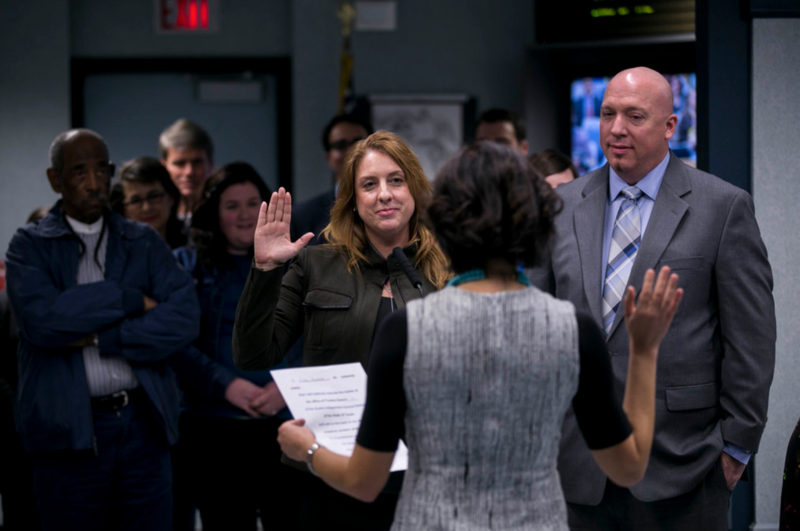Widely regarded as the goddess of Chicana feminism, I count myself among the many who for generations have been nourished by her writings, advocacy, and intellect. She is a true force of nature and national treasure.
And I am so happy and proud to call her my friend.
Love you, Martha!
Angela Valenzuela
c/s
Feminist Martha Cotera fights to represent Chicanas in academia

Photo Credit: Ashley Sanchez | Daily Texan Staff
Editor's note: This is part of a
compilation of stories highlighting the experiences of students
struggling to achieve equal representation on campus.
In a library filled with the sounds of shuffling books and beeping scanners, librarian and Chicana activist Martha Cotera found the words she needed to fuel her movement.
Cotera, a major figure in the Chicana feminism movement, is best known for her activity in La Raza Unida and for her hundreds of published works. La Raza Unida was a Texas-based political party that promoted the election of Mexican-American officials and was a significant part of the Chicano civil rights movement in the ’70s.
During her time with the party, Cotera began to recognize the marginalization of Chicanas within the Mexican-American community and published many works detailing the need to address sexism within that context.
Cotera said her work in Chicana feminism would not have been possible without the services provided by educational institutions. Her identity as a librarian led her to address issues of representation in academic contexts, such as the exclusion of certain community documents from colleges and libraries.
“The work of activist librarians is often disregarded because people think that they’re only filing papers,” Cotera said. “But they provide a valuable service by preserving voices from local communities.”
Cotera’s most popular book, “Diosa y Hembra,” provides a history of Chicanas in the U.S. and is a key piece of literature in the Chicana Feminist discourse, but it isn’t available on the shelves of Austin’s public libraries and can only be found in the Austin History Center archives.
“Libraries are supposed to reflect the communities they serve, but in reality, they represent the societal class hierarchies,” Cotera said. “The dominant class gets to decide what gets put into academia.”
Cotera’s 35-year career as a librarian and as an archivist at the Benson Latin American Collection gave her the experience she needed to help run the Chicana Research and Learning Center, which she co-founded in 1974.
UT alumna Brenda Sendejo, an anthropology professor at Southwestern University, said the creation of the center started a dialogue between the Chicana community and Austin’s universities. The center, which received materials such as newspapers from the Chicana community, provided UT with the resources necessary to create a Chicana Studies curriculum.
“Chicana Studies had already begun to emerge by the mid-1970s, but it didn’t really become established until it got incorporated into college courses,” Sendejo said.
Beyond the realm of academia, Cotera said many feminists have personal stakes in libraries. Here, feminists discovered stories about Our Lady Guadalupe addressing San Juan Diego with assertive statements and used this evidence to associate her with feminism. For the predominately Catholic Chicana population, this provided a symbol of empowerment grounded within the epistemological framework of spirituality.
“We made Our Lady of Guadalupe into a feminist icon by taking away her passivity and turning her into a champion for women,” Cotera said. “In order to do this, we had to do research.”
Cotera said the struggle to free symbols from their oppressive history and turn them into feminist icons is critical to promoting feminism.
Emilio Zamora, a history and Mexican American studies professor said this Chicana feminist tactic is grounded in the Mexican-American penchant for history.
“Mexicans are very historically minded. It’s a part of their daily lives,” Zamora said. “So [Cotera] came to the field from a historical approach. It’s no accident that she became a librarian. She was very interested in the production and dissemination of knowledge.”
Cotera said the social change that Chicana feminists rely on is only made possible through sufficient resources.
“To be liberated, you need information,” Cotera said. “We need to constantly work to preserve it because without it, we don’t have history and we don’t have social change.”
In a library filled with the sounds of shuffling books and beeping scanners, librarian and Chicana activist Martha Cotera found the words she needed to fuel her movement.
Cotera, a major figure in the Chicana feminism movement, is best known for her activity in La Raza Unida and for her hundreds of published works. La Raza Unida was a Texas-based political party that promoted the election of Mexican-American officials and was a significant part of the Chicano civil rights movement in the ’70s.
During her time with the party, Cotera began to recognize the marginalization of Chicanas within the Mexican-American community and published many works detailing the need to address sexism within that context.
Cotera said her work in Chicana feminism would not have been possible without the services provided by educational institutions. Her identity as a librarian led her to address issues of representation in academic contexts, such as the exclusion of certain community documents from colleges and libraries.
“The work of activist librarians is often disregarded because people think that they’re only filing papers,” Cotera said. “But they provide a valuable service by preserving voices from local communities.”
Cotera’s most popular book, “Diosa y Hembra,” provides a history of Chicanas in the U.S. and is a key piece of literature in the Chicana Feminist discourse, but it isn’t available on the shelves of Austin’s public libraries and can only be found in the Austin History Center archives.
“Libraries are supposed to reflect the communities they serve, but in reality, they represent the societal class hierarchies,” Cotera said. “The dominant class gets to decide what gets put into academia.”
Cotera’s 35-year career as a librarian and as an archivist at the Benson Latin American Collection gave her the experience she needed to help run the Chicana Research and Learning Center, which she co-founded in 1974.
UT alumna Brenda Sendejo, an anthropology professor at Southwestern University, said the creation of the center started a dialogue between the Chicana community and Austin’s universities. The center, which received materials such as newspapers from the Chicana community, provided UT with the resources necessary to create a Chicana Studies curriculum.
“Chicana Studies had already begun to emerge by the mid-1970s, but it didn’t really become established until it got incorporated into college courses,” Sendejo said.
Beyond the realm of academia, Cotera said many feminists have personal stakes in libraries. Here, feminists discovered stories about Our Lady Guadalupe addressing San Juan Diego with assertive statements and used this evidence to associate her with feminism. For the predominately Catholic Chicana population, this provided a symbol of empowerment grounded within the epistemological framework of spirituality.
“We made Our Lady of Guadalupe into a feminist icon by taking away her passivity and turning her into a champion for women,” Cotera said. “In order to do this, we had to do research.”
Cotera said the struggle to free symbols from their oppressive history and turn them into feminist icons is critical to promoting feminism.
Emilio Zamora, a history and Mexican American studies professor said this Chicana feminist tactic is grounded in the Mexican-American penchant for history.
“Mexicans are very historically minded. It’s a part of their daily lives,” Zamora said. “So [Cotera] came to the field from a historical approach. It’s no accident that she became a librarian. She was very interested in the production and dissemination of knowledge.”
Cotera said the social change that Chicana feminists rely on is only made possible through sufficient resources.
“To be liberated, you need information,” Cotera said. “We need to constantly work to preserve it because without it, we don’t have history and we don’t have social change.”

 In response to the aftermath of the elections, some 150 college and university
In response to the aftermath of the elections, some 150 college and university 







